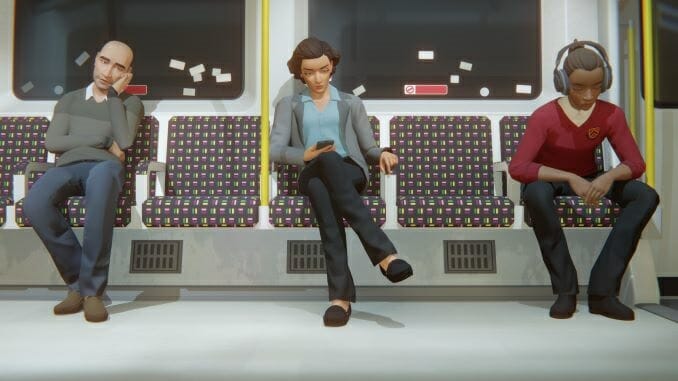So far, both of UK based studios Variable State’s releases primarily concern themselves with location. Both of their titles, Virginia and Last Stop, conjure place. Though Virginia has one playable character, FBI agent Anne Tarver, and Last Stop has three, John, Donna, and Meena, both games focus on a mapped network of intersecting lives. Power and class are inescapable considerations of place and community. They are the source of Virginia and Last Stop’s taut points of tension. While Virginia leans into abstraction, turning its small town, called Kingdom, into a metaphor for America’s shattered heart, Last Stop lovingly renders what feels like real places. In the process, though, it loses its predecessor’s spacial argumentation.
Virginia’s United States is artificial, a plastic country town cobbled together from movies and TV shows. The cold office hallways of the FBI headquarters and Kingdom’s white steepled church draws from the cliches of Americana. However, its artificality allows it both abstraction and scale. To put it simply, Virginia is Twin Peaks moved to America’s heartland and more openly interrogative of its power structures. Virginia’s abstraction is neither ill-researched nor irresponsible, though its clichés do sometimes intrude. Rather, it creates a map of power. Though you return to FBI headquarters several times throughout the game’s dreamy two hours, you are never seen outside of it. The sensation is one of total entrapment. As Anne Tarver’s investigation unfurls, its connections to the heart of the FBI become clearer. The small town’s abusive preacher, the secrets hidden in Anne Tarver’s files, and the FBI headquarters themselves weave into a tapestry of power. It’s hardly an original point, and one covered more compellingly in its inspirations. However, Virginia still hits because of that most video gamey of ideas: repetition.
The entirety of Virginia is in first person and most of it is from Anne Tarver’s perspective. Outside of the FBI headquarters, most of the game takes place in Kingdom. As a consequence, there is a real sense of embodiment. The game takes the time to establish Anne’s routines, and you’ll get dressed for the day and walk down the halls of your office building several times. Through these repetitions, Anne’s relationship to the spaces of the game changes. In one marvelous sequence, Anne imagines herself climbing the FBI’s ranks, eventually taking her boss’s role. With every promotion comes another repetition of events, another marginalized person scrutinized and crushed by the FBI’s surveillance. Through it all, these repetitions emphasize Anne’s position as one node in a massive network of power. At the end of the game, when time and space shatter, it feels like the natural consequence of a person pulled about by her surrounding structures.
In contrast, Last Stop’s scale is at once larger and smaller. The game switches to classic third person perspective, complete with camera contextual controls and fixed angles. Last Stop’s three protagonists all live in different parts of London, though they live close enough to occasionally run into each other. This means that, though you can get familiar with a couple of street layouts, the embodied repetition of Virginia is mostly absent. However, Last Stop trades in an evocative specificity rather than a broad symbology. Everything from the texture of chairs on the underground to the sloping concrete architecture of an apartment complex echoes real world locations. Though, or perhaps because, my memories of the city are hazy and rosey with the distance of youth, these images reverberated through my skull.
Fittingly, some of Last Stop’s most striking moments are in its repetition of day to day life. Donna walks several times to the old swimming pool where she and her friends have set up a hide out. John commutes daily with his daughter to school and then to work. These moments set up a relational normalcy, which is then disrupted by encroaching supernatural forces.
However, the story’s focus quickly shifts away from its character’s relationship with place to an interpersonal drama. Each character gets six “episodes” until their story collides with the others in a final chapter. While this is efficient, the game doesn’t have room for the kind of spacial repetitions Virginia showcases. Each character gets around 30 minutes, a single chapter, before their sense of normalcy is irrevocably shattered. There are magical moments where the game does explicitly play with space. In Donna’s story, as the Stranger she has gotten to know over the past few hours grows more and more threatening, the camera takes an overhead shot, zooming outward until the streets and features of London become shapeless and malformed. It’s an uneasy reflection of Donna’s life falling apart. In another memorable moment, Meena returns to her father’s apartment to find it wrecked. Her father is undisturbed and the conversation while cleaning the house mirrors Meena’s tensions with him. Meena works for a private security agency; her father is a Marxist academic. Their differing attitudes towards the break-in show their interpersonal, as well as their political and systemic, tensions.
Unfortunately, these moments are exceptions. As Last Stop builds to its supernatural climax, London settles into the background and its relationship to its central characters, besides a common location, becomes less clear. As a consequence, the final cosmic shattering of the setting feels far less embodied and personal than Virginia’s climax. This makes Last Stop good enough to be frustrating, which is, sincerely, an exciting place to be. These are formally inventive games, with a sharp cinematic eye and reach despite their problems and limitations. Looking forward to their next project, I hope Variable State manages to make something both embodied and edited, that feels spacial as well as emotional. At any rate, I’m very much looking forward to watching them try.
Grace Benfell is a queer woman, critic, and aspiring fan fiction author. She writes on her blog Grace in the Machine and can be found @grace_machine on Twitter.
